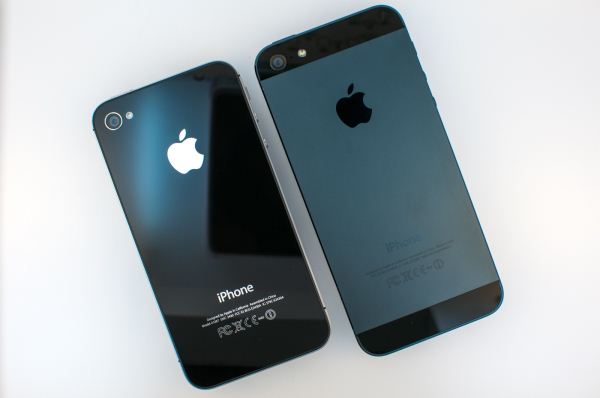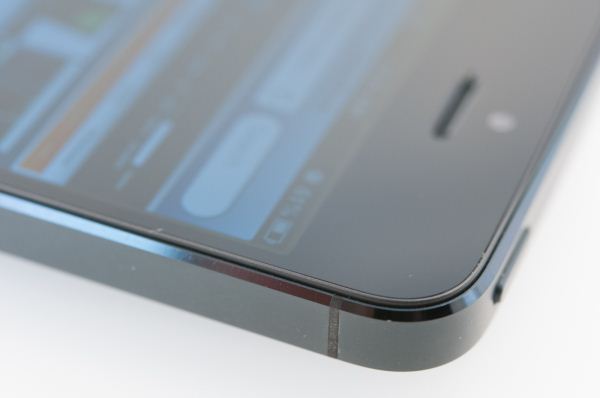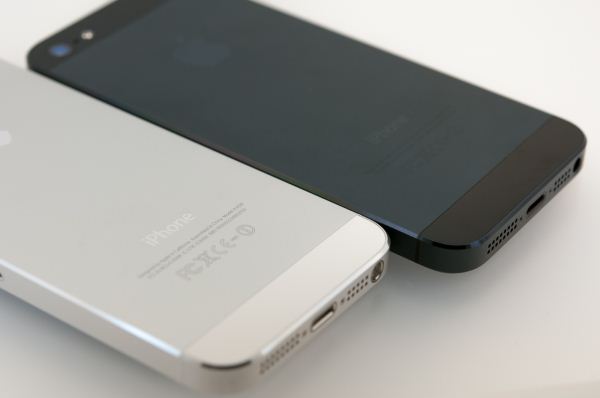The iPhone 5 Review
by Anand Lal Shimpi, Brian Klug & Vivek Gowri on October 16, 2012 11:33 AM EST- Posted in
- Smartphones
- Apple
- Mobile
- iPhone 5
Design
Section by Vivek Gowri
The iPhone 4, when it launched, represented a clean break for Apple's industrial design. It replaced the soft organic curvature of the iPhone 3G/3GS with a detailed sandwich of metal and glass, something that arguably brought the feel of a premium device to a new level. Obviously, Apple had their fair share of issues with the design initially, and nothing could match the sinking feeling of dropping one and shattering the glass on the front and back simultaneously, but it was a small price to pay for the jewel-like feel of the device. Combined with the (at the time) incredible pixel density of the then-new Retina Display, the iPhone 4 was a revolution in hardware design. The chassis has aged remarkably well over the last two-plus years, so naturally it's a hard act to follow.
The 5 keeps a similar design language to the 4, keeping roughly the same shape as before but with a taller and thinner form factor. At first glance, the 5 actually looks almost the same as the 4, with an unbroken glass front face, prominent corner radiuses, the familiar home button, a rectangular cross-section, and metallic sides with plastic antenna bands. However, those metallic sides are part of an anodized aluminum frame that makes up a majority of the body, and that's where the industrial design diverges from the 4 and 4S.
In contrast to the predominantly glass body of the previous generation iPhone, the 5 is almost entirely aluminum other than the glass front face and two small glass windows at the top and bottom of the back. It's a return to the original iPhone/3G/3GS-style of construction, with the front glass clipping into a unibody chassis. It's a significant departure from the 4 and 4S, where the stainless steel band in the center was the main housing that the front and rear panels clipped into. That was pretty radical way of doing things, so it's not all that surprising to see Apple revert to a more conventional and less complex method for the 5.
The aesthetic is actually pretty awesome, especially in the black version. The combination of black glass and off-black aluminum (Apple is calling it slate) gives the 5 an almost murdered out look that's three parts elegant and one part evil. The white and silver model has a classy look that's much friendlier in appearance than the black one. The color schemes and overall design aesthetic remind me of the Dell Adamo, one of my favorite notebook designs of all time. The similarities may be purely coincidental, but it's interesting to note nonetheless and should give you an idea of how premium the industrial design is.
All three previous iPhone body styles had very similar dimensions, so the biggest question with the 5 was how much the larger display would do to change that. Unlike many Android manufacturers, Apple still believes in things like small pockets, small hands, and one-handed smartphone usage. With the 5 being vertically stretched but no wider than the previous iPhones, the biggest impact on in-hand feel is actually the thinner body. If you're used to a larger Android or Windows device, the change seems radical, but even compared to the 22% thicker iPhone 4S, it feels a good deal smaller.
It's not just the minimized z-height though, the 25% weight loss is definitely also a factor. Even a few weeks later, I still find it striking how much less substantial it feels than the 4 and 4S. The densely-packed glass body just had a reassuring weight to it that the 5 simply lacks. But as you get used to the new form factor, you realize how far Apple is pushing the boundaries of ultrathin design. When the 4th generation iPod touch came out, I told Brian that I wanted an iPhone with that form factor - well, the 5 is essentially there (0.3mm thicker and 11 grams heavier, but close enough). It's pretty impressive to think about. If you thought the 4S was one of the best phone designs on the market in terms of aesthetics and build quality, the iPhone 5 just pushes that advantage further.



















276 Comments
View All Comments
themossie - Tuesday, October 16, 2012 - link
The manufacturer's charger uses a set of pull-up resistors connected between the various USB lines, to indicate that the phone can pull maximum current. Unfortunately, every manufacturer (and sometimes different phones) use different resistances.See http://electronics.stackexchange.com/questions/144... for a brief writeup.
For what it's worth, I've only had this problem with iDevices and the HP Touchpad. I own circa-2011+ HTC, Motorola and Samsung phones, and they all work fine with every charger. My Droid 2 Global was my primary work phone until a few months ago, and works great with every charger. Not sure why your wife is having problems there.
crankerchick - Tuesday, October 16, 2012 - link
"The non-LTE phones see a sharp drop in battery life. At least at 28nm the slower air interfaces simply have to remain active (and drawing power) for longer, which results in measurably worse battery life. Again, the thing to be careful of here is there's usually a correlation between network speed and how aggressive you use the device. With a workload that scaled with network speed you might see closer numbers between 3G and 4G LTE."Perhaps you all could devise a test for this? Something like, change your LTE and 3G tests, where you decrease the time between page loads for the LTE test, to simulate doing more browsing since the pages load faster? One data point on this, with a reasonably selected change in page load duration, would be very helpful now that we have this very interesting dynamic clearly visible.
That said, as always, I appreciate the reviews presented here. Always thorough with lots of information to chew on beyond specs and "user opinion on user experience."
Just wish the reviews didn't take so long, but they are always worth it in the end.
TofDriver - Tuesday, October 16, 2012 - link
Thanks for this awesome article. Gigantic work, we'll worth the wait.I've learnt so much.
Would still appreciate it as an ebook, even after the web reading!
Seems like you're perfectionists who love to push limits... To me it does resonate with the team who designed the reviewed product.
name99 - Tuesday, October 16, 2012 - link
"Another potential explanation is that the 3-wide front end allowed for better utilization of the existing two ALUs, although it's also unlikely that we see better than perfect scaling simply due to the addition of an extra decoder."Remember the standard numbers. On this type of integer code:
1/6 instructions are branch
1/6 instructions are store
1/3 instructions are load
1/3 instructions are ALU
This means the usual first throttling point i cache access, if you can only do one load/store cycle.
If you limit your cache to one op/cycle, it's generally not worth going beyond 2-wide --- too often you're waiting on the cache.
Once you widen your cache (usually, at this stage, by allowing simultaneous read and write per cycle) three-wide makes sense.
Each cycle now (on ideal and some sort of "average" idealized code) you can now do some sort of combination of half a branch, 1.5 load/stores, and 1 ALU. Meaning that 2 ALUs (as long as they are not overloaded and also handling some aspect of the load/store) is enough for now.
[Of course things never work out quite this ideal --- you have burstiness in operation types, not to mention delays. But the compiler should try to schedule instructions to get this sort of average, and likewise the re-order queues will do what they can to shuffle things to this sort of average. 2ALUs helps with the bursts, 3ALUs is overkill.]
So I would say the primary important change made to go to three-wide in a way that is not a waste of time was to convert the L1 cache to dual-ported, supporting simultaneous load & store per cycle.
jiffylube1024 - Tuesday, October 16, 2012 - link
I have to commend the Anandtech team for the great review! It was a long wait, but well worth it. The info on anodizing, the "Swift" CPU @ 1.3 GHz, camera performance, etc. was worth waiting for. This article, in my eyes, is a culmination of the Anandtech team's knowledge in the tech industry - deconstructing A6 to figure out what it's made of, discussing Apple's manufacturing capabilities, etc. Very informative and well written!I am always amazed at how many complaints (and petty platform wars) get exposed on the comment board. I certainly appreciate them when an article is poorly written, contains false information or outright lies, but with an article like this, the comments section seems shy of the effusive praise it deserves!
------
On a slight tangent, I've enjoyed the first 8 Anandtech podcasts as well, and I have to say that I look forward to more non-iPhone related disucssion on future podcasts. The information was much appreciated, but for a tech site as broad as Anandtech, the first 8 podcasts have been VERY iPhone heavy in their content! Keep up the good work.
jamyryals - Thursday, October 18, 2012 - link
I think you're right, it has been iPhone heavy, but the start of the podcast kind of lined up with the launch/review process. Let's be honest, it is a huge selling high quality device and it's treated as such. I have a feeling Brian and Anand will have a lot to say about all of the impending Nexii/WP8 when they come out this quarter.krumme - Tuesday, October 16, 2012 - link
Good to see reviewers apreciation of low light capabilities for the BSI sensor, reflecting real world usage. Oposite to a lot of uninformed stupid reviews on the net.Its exactly the same practical difference between s2 and s3 cameras. Big difference for real usage.
All the mpix race must stop now. 8M is way to much for the quality anyway.
Zanegray - Tuesday, October 16, 2012 - link
I love the level of analysis and attention to detail. Keep it up!mrdude - Tuesday, October 16, 2012 - link
Wow, what an article. Really fantastic read. The lengths you guys have gone to in this review is stunning, frankly. Well done. Although I'm no Apple fanatic, I must say that this is one of the better articles I've read on AT :)Dennis Travis - Tuesday, October 16, 2012 - link
Totally outstanding review. You guys covered everything. Thanks so much!